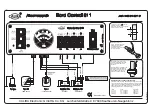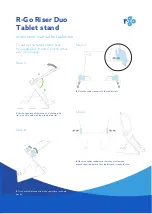
Analog Signal Conditioner
AD-4541-V (Voltage output type), AD-4541-I (Current output type)
Instruction Manual
1. Outline
AD-4541-V and AD-4541-I are analog signal conditioners utilizing a load cell or strain gauge as sensor input and converts signals
such as mass, acceleration, pressure and torque at the signal level, to an output suitable for a PLC or PC analog input.
The conditioners can be mounted on a DIN rail or on the wall.
2. Specifications
Category Item
Description
Input
Zero adjustment range
-0.5 mV/V to +0.5 mV/V
Span adjustment range
0.4 mV/V to 3.2 mV/V
Non-linearity
0.05% of F.S. typ.
Loadcell excitation
5 VDC 60 mA max. (Can be used with one loadcell of 120
Ω
or maximum four loadcells of 350
Ω
)
Zero temperature coefficient
2
μ
V/°C RTI typ.
Span temperature coefficient 200ppm/°C typ.
Frequency response
DC to 2 Hz
(
-3dB
)
Response
Approx. 190 ms (0% to 90%)
Input
noise
2
μ
Vp-p RTI typ.
Calibration standard
1 mV/V
±
0.2% typ.
Output
Voltage output (AD-4541-V)
-2 V to +2 V (Load 2k
Ω
or higher)
Current output (AD-4541-I)
4 mA to 20 mA (Load 250
Ω
or lower)
Power
Voltage
24 VDC +10%-15%
Current
100 mA max (Approx. 2.4W)
General
Operating temperature
-5°C to +50°C
Operating humidity
85%RH or lower (No condensation)
Storage temperature
-20°C to +70°C
External dimensions
45W x 122H x 24D mm
Mass
Approx. 90 g
Others
Terminal
Spring clamp type
Wire 0.08 mm
2
to 1.5 mm
2
(AWG 28-14) Maximum outside diameter 3.4 mm
Installation
DIN rail or screw
Material (Body)
PBT (V0)
Isolation
Input output to power supply
Insulation resistance
500 VDC for 1 min
Accessories
Flathead screwdriver 1 pc, Instruction manual (this document) 1 pc
3. External dimensions
4. Block Diagram
5. Installation
•
Mounting on the DIN rail
Using the accessory screwdriver, push out the DIN rail mounting spring located at the
bottom of the casing and secure the casing on the DIN rail.
•
Using the screws
Using the holes on four corners, the casing can be secured on the wall with the screws.
6. Cable connection
Caution: Before cable connection, be sure to turn the power off.
Insert the accessory screwdriver perpendicularly into the terminal block as shown in the
illustration to the right, until stopped. At this time, do not rotate or twist the screwdriver.
The screwdriver, when inserted firmly, stands alone.
With the screwdriver inserted, insert the cable and pull out the screwdriver to connect the cable.
To disconnect the cable, insert the screwdriver and pull out the cable.
Remove the insulation from the cable tip to expose cables 5 to 6 mm long. Twist the cables
lightly and connect to the terminal block. (See the illustration below.)
7. Calibration
(1) Zero adjustment
With no load on the sensor, use the zero adjustment control to adjust the conditioner so that the analog output will be the zero point.
(2) Span adjustment
With load on the sensor, use the span adjustment control to adjust the conditioner so that the analog output will be the designated value.
If no load is to be applied to the sensor, use the CAL switch to add a pseudo value of 1 mV/V to the input and make an adjustment.
* Repeating the above adjustments several times will improve the accuracy.
8. Precautions
•
Install the conditioner securely so that it is free from vibrations and impact.
•
Be sure to turn the power off before cable connection.
•
Keep the interior free of dust and foreign materials. They may cause the damage to the conditioner.
•
When connecting cables or operating the controls and CAL switch, use the accessory screwdriver.
•
When operating the controls and CAL switch, be sure to insert the screwdriver perpendicularly. Inserting the screwdriver with a tilt
may cause a short circuit.
•
The zero adjustment and span adjustment controls have a maximum number of revolutions of 15. Do not rotate them more than
necessary.
•
Do not disassemble or modify the conditioner.
It may cause the damage to the conditioner.
•
Avoid condensation during operation and storage.
•
Do not immerse the conditioner in water.
Input
Output
LC excitation
5 VDC
Level converter
-2 to +2V
or
4 to 20 mA
*Depends on the
model
Analog output
Power 24 VDC
Loadcell
or
strain gauge
LPF
Amplifier
SIG+
SIG-
EXC+
EXC-
OUT+
Voltage or current output
OUT-
SHD
Output shield
POWER-
Input shield
SHD
Offset/gain
adjustment
Standard
1 mV/V
Sensor input
DC/DC converter
POWER+
Two sets of two terminals
in parallel. Use them for
crossover connection.
With isolation
Insert the
screwdriver
perpendicularly
5 to 6 mm
Cable treatment
The illustration below is the AD-4541-V.
The size of the AD-4541-1 is the same as
the AD-4541-V.
Zero adjustment
control
Sensor input terminal
Span adjustment
control
CAL switch
When pressed, a pseudo
value of 1mV/V is added
to the input.
Analog output terminal
and power terminal
DIN rail mounting spring
Unit: mm



















